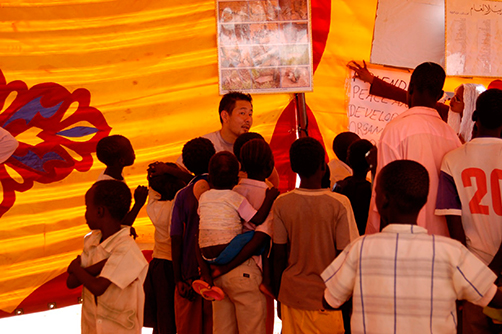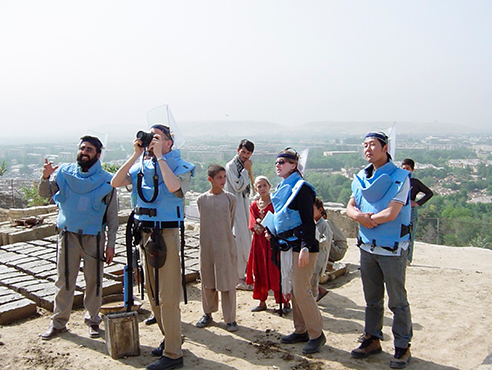Stories from the Field 4
Voices of Japanese Personnel Working in International Organizations
– Toward the Eradication of Landmine Victims
When hearing the word “Mine Action,” many people will probably come up with activities to remove antipersonnel landmines. However, in reality, the dangers that affect citizens, refugees, and displaced persons are not limited to landmines, but range widely, including unexploded ordnances (UXOs) of all kinds used in conflicts, and improvised explosive devices (IEDs) set in houses and infrastructure facilities. Thus, the activities for dealing with these have become equally wide-ranging. In addition to the clearance of landmines and UXOs, mine risk education is also an important activity. Moreover, victim assistance is essential even after the clearance of landmines and UXOs has been completed. Therefore, long-term assistance is required in regions where there are many victims, particularly youths.

Conducting mine risk education for children at an Internally Displaced Persons (IDPs) camp in the outskirts of Khartoum, Sudan (author center) (Photo: UNMAS)
Mine Action is one of the important activities at any stage of conflict, and its outcome will contribute to peacekeeping operations, post-conflict reconstruction, peacebuilding, development and more. Moreover, mine clearance will not only bring humanitarian and preventive outcomes such as saving lives and preventing injuries, but also bring positive socioeconomic impact by freeing land for residential areas, farmland, schools, hospitals, and water filtration plants.
During the approximate 16 years since I was assigned to Afghanistan in 2002, I have been involved in UN mine action projects in more than 20 countries. Through my engagement, I am convinced that my work is connected with people’s lives in various ways, a sense of fulfilment that I can support people risking their lives in the field, and the people’s hope for the future of their own countries. These are the motivation for my daily work.

Monitoring visit of landmine clearance activities in Kabul, Afghanistan (author far right) (Photo: UNMAS)
In Iraq, among the IEDs set in the houses of a village where ISIL withdrew from, there was a terrible case of a device hidden in a stuffed animal that would explode if a child touches it. I greatly admire my colleagues’ bravery to work on the clearance of these explosives, and my heart ached when I imagined that my daughter had been in the same situation.
In 2003, when I was working in Afghanistan, there was a minefield in the outskirts of Kabul that was technically difficult and extremely dangerous for clearance. I worked hard to obtain a budget for it, and went to the site frequently to write up reports. Around ten years later, when I visited the site again on a mission, I was deeply moved by the site of many houses built side by side and children running around.
At the end of 2018, I had the opportunity to attend a completion ceremony of clearing existent UXOs in the Kulbus region of West Darfur (Sudan), as a representative of our Headquarters. Kulbus is one of the regions where the War in Darfur was most severe, and it took one year and a month to clear the large number of UXOs while conducting mine risk education to the local people. As a result of this operation, the safety of approximately 32,000 residents and displaced persons was secured. Seeing the happy faces of the local people at the ceremony, and thinking that post-conflict reconstruction would unfold without any more victims, as long as there is no further conflict in the region, I felt a sense of achievement that I had been able to contribute to the peace-building process.
Currently, I supervise activities in 17 countries as Deputy Chief of Program Management in the United Nations Mine Action Service (UNMAS), in the Headquarters of the United Nations in New York. I hope I can make use of my experience, what I saw and felt in the field, in my current daily work.
Takuto Kubo
Deputy Chief of Program Management
United Nations Mine Action Service (UNMAS)
<< Previous Page Next Page >>
Main Text | Reference Statistics | Stories from the Field | Master Techniques from Japan to the World | ODA Topics
